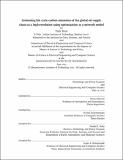Estimating life cycle carbon emissions of the global oil supply chain at a high-resolution using optimization in a network model
Author(s)
Dixit, Yash
DownloadThesis PDF (4.903Mb)
Advisor
Barrett, Steven
Terms of use
Metadata
Show full item recordAbstract
Climate change, being the multi-faceted problem that it is, requires aggressive decarbonization across the entire life cycle. With the evolving energy mix, the oil industry is in a phase of adaptation. At present, petroleum fuels account for a third of the global primary energy supply. Future forecasts range across a spectrum from plateauing to decreasing supply, up to a 40 percent decrease from present levels [1]. Furthermore, certain applications such as aviation and petrochemicals have limited short-term, scalable alternatives. On this backdrop, there is an increasing push for better emissions reporting throughout the supply chain and regulatory mandates at making climate friendly choices. Notable examples include the Low Carbon Fuel Standard by the California Air Resources Board [2] and the Fuel Quality Directive by European regulators [3]. Existing literature is directionally aligned with these efforts, in that it points towards carbon accounting in the supply chain. However, studies are either limited to specific processes (e.g: crude oil extraction) and/or regions (e.g: North America). Furthermore, those with a wider scope including all phases of the supply chain, have a poor resolution whereby the carbon accounting is done at the level of countries and is thus unable to capture the complexities associated with oil trade. These inadequacies stem from poor availability of data and methodological challenges which fail to accurately portray the heterogeneity in life cycle emissions. The thesis quantifies this heterogeneity using a market-based approach that addresses the aforementioned limitations by estimating the life cycle carbon intensity of crude oil trades from sources (oil fields) to destinations (refineries). With a scope that includes crude extraction and transportation, the emission modeling is undertaken using high-fidelity commercial datasets, existing emission estimators and computational techniques based on optimization. The thesis concludes that globally, the carbon footprint variability ranges from 1.80 to 32.92 gCO₂/MJ with a volume weighted mean of 9.73 gCO₂/MJ. This variability coupled with supply forecasts up to 2050 from low-carbon scenarios amount to additional CO₂ savings of 2-5 GT.
Date issued
2021-06Department
Massachusetts Institute of Technology. Department of Electrical Engineering and Computer Science; Massachusetts Institute of Technology. Institute for Data, Systems, and SocietyPublisher
Massachusetts Institute of Technology